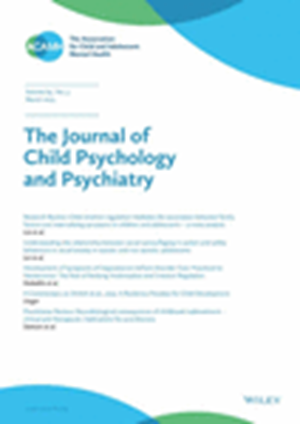社交情境信息对青少年社交焦虑障碍面孔神经加工的影响。
IF 7
1区 医学
Q1 PSYCHIATRY
引用次数: 0
摘要
青少年社交焦虑障碍(SAD)与显著的社会心理障碍相关;然而,维持它的认知和神经机制,特别是在儿童和青少年时期,仍然没有得到充分的探索。认知模型强调改变面部处理的作用,中性的面部表情可能被认为是威胁。由于其模棱两可的性质,上下文线索可能在解释中起着特别重要的作用。方法将中性儿童面孔与不同效价(阴性、中性、阳性)的社会背景信息配对,同时记录连续脑电图。对10-15岁儿童和青少年SAD患者(n = 53)的主观效价评分和神经反应(P100、N170和LPP)进行评估;n = 41)和健康对照(HC;n = 61)。结果总体而言,情境信息对所有儿童和青少年对中性面孔的主观和神经反应都有影响,例如,对负面情境化的面孔有更多的负面评价。此外,与hc相比,患有SAD的参与者通常认为所有面孔都更消极。在神经上,与两个对照组相比,他们对所有中性面孔的反应显示出较低的N170振幅,与上下文效价无关。然而,只有年龄较小的儿童(10-12岁)患有SAD,其LPP振幅高于年龄较小的hc。结论加工偏差在儿童和青少年SAD患者中似乎已经存在,无论是在主观层面还是在神经层面。社会情境信息影响中性面孔加工,但与精神病理无关。未来的研究需要考察年龄的影响,以调查童年是否反映了加工偏见发展的特别敏感时期。本文章由计算机程序翻译,如有差异,请以英文原文为准。
Effects of social context information on neural face processing in youth with social anxiety disorder.
BACKGROUND
Social anxiety disorder (SAD) in youth is associated with significant psychosocial impairments; however, the cognitive and neural mechanisms that maintain it, particularly during childhood and adolescence, remain underexplored. Cognitive models emphasize the role of altered face processing, and neutral facial expressions may be perceived as threatening. Due to their ambiguous nature, contextual cues may play a particularly important role in interpretation.
METHODS
We presented neutral child faces paired with social context information varying in valence (negative, neutral, positive) while continuous EEG was recorded. Subjective valence ratings and neural responses (P100, N170, and LPP) were assessed in children and adolescents aged 10-15 years with SAD (n = 53), clinical controls with specific phobias (SP; n = 41), and healthy controls (HC; n = 61).
RESULTS
Overall, context information affected both the subjective and neural responses to neutral faces in all children and adolescents, for example, more negative ratings for negatively contextualized faces. Further, participants with SAD generally rated all faces as more negative compared to HCs. Neurally, they showed lower N170 amplitudes compared to both control groups in response to all neutral faces, independent of the context valence. However, only younger children (aged 10-12 years) with SAD showed higher LPP amplitudes than younger HCs.
CONCLUSIONS
Processing biases seem to be already present in children and adolescents with SAD, both at the subjective and neural level. Social context information influences neutral face processing but is independent of psychopathology. Future studies examining age effects are needed to investigate whether childhood reflects a particularly sensitive period for the development of processing biases.
求助全文
通过发布文献求助,成功后即可免费获取论文全文。
去求助
来源期刊
CiteScore
13.80
自引率
5.30%
发文量
169
审稿时长
1 months
期刊介绍:
The Journal of Child Psychology and Psychiatry (JCPP) is a highly regarded international publication that focuses on the fields of child and adolescent psychology and psychiatry. It is recognized for publishing top-tier, clinically relevant research across various disciplines related to these areas. JCPP has a broad global readership and covers a diverse range of topics, including:
Epidemiology: Studies on the prevalence and distribution of mental health issues in children and adolescents.
Diagnosis: Research on the identification and classification of childhood disorders.
Treatments: Psychotherapeutic and psychopharmacological interventions for child and adolescent mental health.
Behavior and Cognition: Studies on the behavioral and cognitive aspects of childhood disorders.
Neuroscience and Neurobiology: Research on the neural and biological underpinnings of child mental health.
Genetics: Genetic factors contributing to the development of childhood disorders.
JCPP serves as a platform for integrating empirical research, clinical studies, and high-quality reviews from diverse perspectives, theoretical viewpoints, and disciplines. This interdisciplinary approach is a key feature of the journal, as it fosters a comprehensive understanding of child and adolescent mental health.
The Journal of Child Psychology and Psychiatry is published 12 times a year and is affiliated with the Association for Child and Adolescent Mental Health (ACAMH), which supports the journal's mission to advance knowledge and practice in the field of child and adolescent mental health.

 求助内容:
求助内容: 应助结果提醒方式:
应助结果提醒方式:


